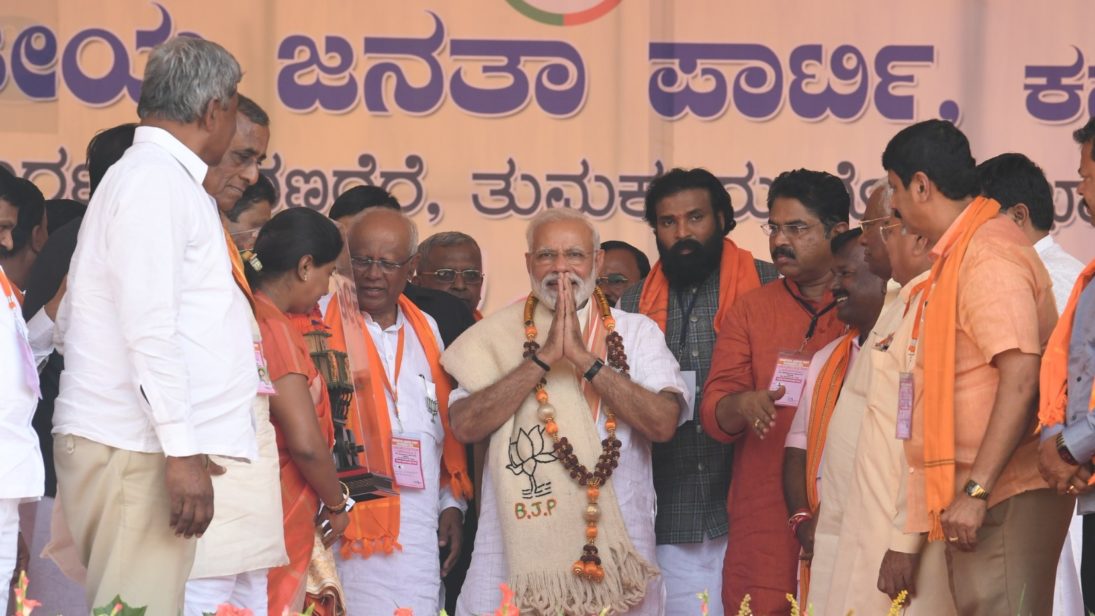
In the 2014 Lok Sabha elections, the Narendra Modi-led Bhartiya Janata Party (BJP) won 205 seats out of its total of 282 from India’s northern and western states. However, despite the “Modi wave” that swept the country, the BJP was able to win only 21 seats in the southern states of Tamil Nadu, Kerala, Andhra Pradesh, Telangana, and Karnataka, of which 17 came from Karnataka alone (see Figure 1). The 2014 elections showed that once again, South India proved to be a fortress against the BJP. Will 2019 be different? This article argues that despite the BJP’s efforts to turn its fortunes in the region, the southern states will remain its Achilles’ heel in these elections.
South India is represented by 130 seats in the Lok Sabha, forming around one-fourth of the total 545 seats up for grabs. The lack of support for the BJP in the region thus far stems from its perception as a North Indian, Hindi-speaking party trying to appeal to non-Hindi speaking states whose culture varies from the north. Instead, a plethora of regional parties dominate the political landscape of these states, reiterating the differences prevalent among them. Though notable exceptions are Karnataka and Kerala.
Recently, the BJP turned its attention onto the southern states because its chances of replicating its 2014 performance in the northern and western states have slimmed due to several factors. Firstly, the pre-poll alliance between the Bahujan Samaj Party and the Samajwadi Party in Uttar Pradesh, a state which contributes the highest number of seats to the Lok Sabha, is likely to erode the BJP’s dominating performance there in 2014, when it bagged 71 out of 80 seats. Further, the Indian National Congress has shown somewhat of a resurgence by winning three recent state elections in Madhya Pradesh, Rajasthan and Chhattisgarh, which all lie in the Hindi heartland. Considering this, it will be hard for the BJP to recreate its 2014 magic when it had won all of Rajasthan’s 25 seats, 27 out of 29 in Madhya Pradesh, and 10 out of 11 in Chhattisgarh.
TheBJP’s efforts to register a strong showing in the southern states in the 2019elections include striking alliances with regional parties and a strategy ofexacerbating cleavages over sensitive religious issues. This is not to say thatSouth India is or should be treated as a single entity. The issues andpolitical dynamics that dominate each state vary.
In Tamil Nadu, the BJP has entered a pre-poll alliance with the All India Anna Dravida Munnetra Kazhagam (AIADMK) that currently governs the state. Such an alliance would have been unthinkable under former AIADMK supremo Late Jayalalithaa, who ruled Tamil Nadu for over 12 years and opposed the policies of the BJP that were perceived as detrimental to the state. However, some of those policies have been supported by the current dispensation of the AIADMK, ostensibly to hold on to power with the support of the BJP, which is being seen as a betrayal by the state’s voters. Further, the BJP’s poor handling of natural disasters in the state as well as its indifference to the farmers’ plight have led to campaigns against Modi on social media. For instance, the BJP sanctioned a paltry USD 217 million as assistance in the aftermath of Cyclone Gaja in Tamil Nadu in 2018 as against the request of over USD 2.6 billion. Thus, both the BJP and the AIADMK have contributed to each other’s unpopularity in Tamil Nadu. This may explain why a recent Times Now-VMR opinion poll predicts that the rival regional party Dravida Munnetra Kazhagam is likely to win the state leaving the BJP-AIADMK alliance with only 5 out of 39 seats.
Recently, the BJP turned its attention onto the southern states because its chances of replicating its 2014 performance in the northern and western states have slimmed due to several factors. […] The BJP’s efforts to register a strong showing in the southern states in the 2019 elections include striking alliances with regional parties and a strategy of exacerbating cleavages over sensitive religious issues.
In Andhra Pradesh, the BJP lost a significant ally in the Telugu Desam Party (TDP), which had supported the BJP through thick and thin. The 2014 election was important in Andhra Pradesh at both the state and central levels because the then government was keen on passing a bill that would bifurcate the state into two – an outcome of a movement that had been going on sporadically since the 1960s. When Andhra lost its capital to Telangana, then prime minister Manmohan Singh promised to accord the state Special Category Status (SCS) for five years to help it get back on its feet. While campaigning for the 2014 election, the BJP promised that Andhra’s SCS status would be extended to ten years. However, when the party came to power, it failed to act on its promise. The TDP and the state’s voters state have seen this as a betrayal of Andhra Pradesh. As a result, no regional party wants to be seen as supporting the BJP or seeking an alliance with it because that will alienate their voters. The only hope for the BJP is to count on the rivalry between the regional parties to yield some support externally, but that too is subject to it delivering on its promise of extending the SCS.
In Telangana, the Telangana Rashtra Samiti (TRS), which has been pivotal in the creation of the state and whose chief almost single-handedly led the Final Telangana Movement from the 1990s onwards, is expected to sweep the elections, especially after its strong performance in both 2014 and in 2018. While the BJP could expect support from TRS, it can manage only a couple of seats on its own.
Kerala is likely to be a test for whether the BJP’s tactics of leveraging the Hindu identity politically to reap electoral benefits have worked. For instance, the BJP’s politics of cow protection goes against the common practice of consuming beef across most communities in Kerala. Thus, the BJP’s attempts to bring about a beef ban were slammed in Kerala and met with opposition from the state government as well as mass opprobrium. However, the Sabarimala Temple issue may play out differently. The controversy stems from a Supreme Court(SC) decision that ruled in favor of allowing women of menstruating age into the Sabrimala temple premises. This is a polarizing issue among the Hindu community in Kerala and though the state government opposed the SC ruling, it may have won the BJP some votes. Thus, the party that has never secured more than 11 per cent vote share in the state is hoping for a strong performance that could potentially lead to the BJP picking up its first ever seat in Kerala.
The silver lining for the BJP in the south is the party’s prospects in Karnataka, where it is expected to win 15 seats, according to the Times Now-VMR opinion poll. However, even with this strong showing, it will be the party’s worst performance in the state since 2004 (see Figure 1).
Even the BJP’s go-to move when it is facing a challenge–drawing on the campaigning skills of Prime Minister Modi–might not work in South India. A recent C-Voter survey shows that the southern states is where Modi enjoys the least support—for instance, in Tamil Nadu, only 2.2 per cent of respondents have a positive view of him. Perhaps the BJP figured this out and hence made an early shift towards eastern states such as West Bengal and Orissa and those in Northeast India, hoping to make up for lost ground.
On the other hand, the Rahul Gandhi-led Indian National Congress is expected to do much better than the BJP. The Congress has formed a pre-poll alliance with the DMK, which is expected to sweep Tamil Nadu, and an alliance with the Janata Dal (Secular) in Karnataka, which is expected to give the BJP tough competition. Further, the Congress has demonstrated its commitment to the South by fielding party president Rahul Gandhi from the Wayanad constituency in Kerala– a move that has been well-regarded in the region.
From this picture, the prospect of the BJP making tremendous gains in the southern states is unlikely. What this means for the party’s effort to gain power nationally is that its strategy of making up in the south the votes it expects to lose in the north and in the Hindi heartland may not work. Particularly in the case of close contests, which 2019 is likely to be, the southern states can matter a lot despite their lower share of seats. While the polls do not give a clear picture in terms of who would form the government at the national level, it would be a folly for the BJP to count on support from South India.
***
Image: Narendra Modi via Twitter


